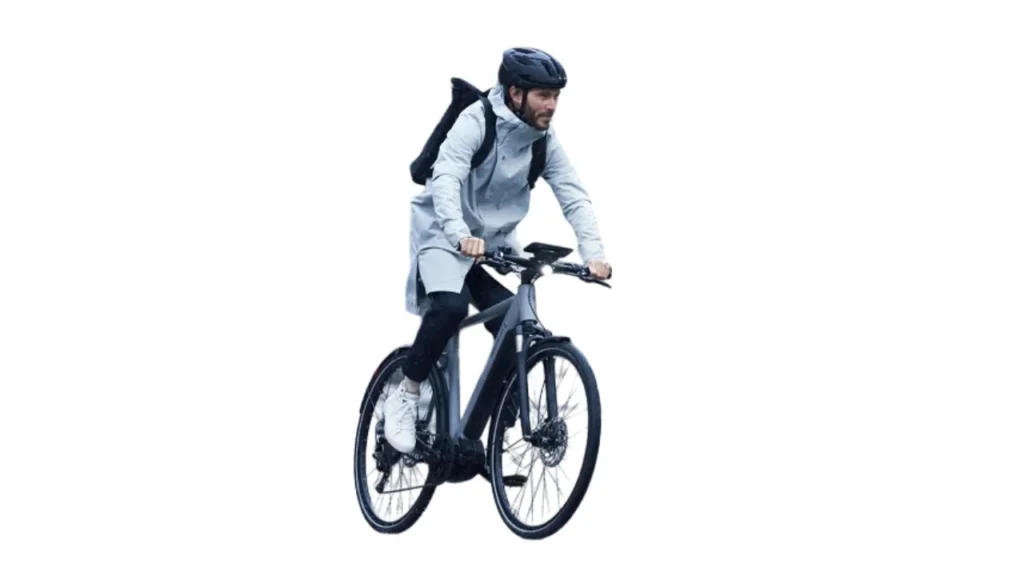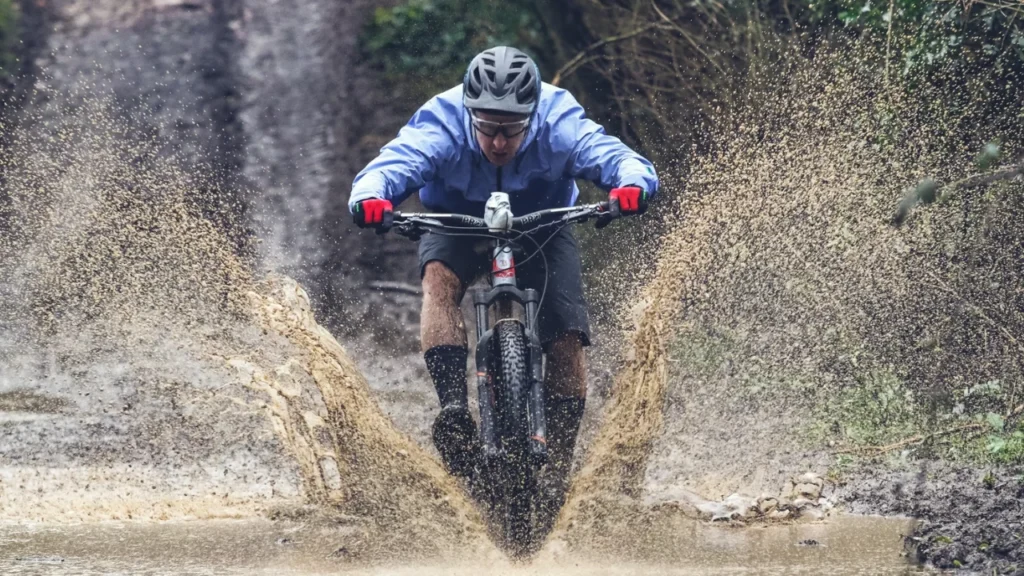Can electric bikes get wet? Electric bikes are designed to withstand various weather conditions, including rain. While the combination of electricity and water may raise concerns, the industry has developed electric bike components to be water-resistant.
E-bikes can indeed get wet without significant issues. Manufacturers have implemented measures to protect the electrical components from moisture, ensuring the bike’s functionality even in rainy weather.
Electric bikes feature sealed electrical systems and components to prevent water damage. Regular maintenance, such as drying the bike after exposure to rain and keeping connections clean, can help prolong its lifespan.
When not in use, storing the electric bike in a dry place can further protect it from moisture. By understanding the design and capabilities of electric bikes, riders can confidently enjoy their electric bike rides in wet weather conditions.
Factors to Consider When Riding Electric Bikes in Wet Conditions
Riding an electric bike in wet weather can present challenges and risks, but with proper precautions, it is possible to stay safe and enjoy the experience. When considering riding your e-bike in rainy conditions, keep the following key factors in mind:

Water Resistance
Some electric bikes are designed to be water-resistant, while others are not. When selecting an e-bike, look for models with an IP rating that indicates their level of water resistance. A higher rating suggests the bike can withstand more water exposure and is better suited for wet conditions.
Motor Power
The motor’s power can influence the bike’s performance in wet weather. A higher-powered motor can offer better traction and stability but may be more challenging to control on slippery surfaces. If you are a novice rider, opt for a bike with a lower-powered motor to minimize risks.
Battery Type
Lithium-ion batteries, commonly used in electric bikes, are vulnerable to water damage. Avoid submerging your e-bike or exposing the battery to rain or puddles. If riding in wet conditions is necessary, consider using a battery cover or waterproof bag for protection.
Tire Traction
Tires play a crucial role in providing grip and stability in wet conditions. Choose tires with a deeper tread pattern that can effectively disperse water and offer superior traction. Additionally, ensure proper tire pressure is maintained for optimal performance.
By considering these factors and taking appropriate precautions, you can safely and enjoyably ride your electric bike in wet weather.
- Also Read: How to Choose an Electric Bike
IP Ratings
Manufacturers often state that their bikes are not waterproof, which can lead to misunderstandings. However, it’s important to note that being waterproof and being able to withstand wet conditions are not the same thing.
What is IP Rating?
IP (Ingress Protection) ratings are used to indicate the level of protection against water and dust ingress. These ratings provide a more specific and accurate answer to the question of how wet an electric bike can get.
The first digit signifies the extent of protection against solid substances like dust, while the second digit indicates the level of protection against water.
For example, many electric bikes carry an IP-65 rating. This means that the bike is dust-tight and protected against low-pressure water jets from any direction.
However, it does not mean that the bike can be submerged in water or ridden through deep puddles without any issues.
Checking with Manufacturers
It’s always best to check with the manufacturer of your specific electric bike model to determine its IP rating and the recommended limits for water exposure. You can find this information in the bike’s manual or on the manufacturer’s website.
By understanding the IP rating and the specific water resistance capabilities of your electric bike, you can confidently ride in wet conditions while taking necessary precautions to protect the bike’s electrical components.
Do’s and Don’ts
Armed with knowledge of pertinent inquiries and anticipated outcomes, let’s delve into fundamental dos and don’ts.
Do
Commencing with the recommended actions, the list can be succinctly summarized:
- Treat your electric bike like a regular bike.
- Feel free to ride it in various weather conditions, including rain, mud, and dirt without hesitation.
- A crucial practice is to maintain cleanliness and maintenance, especially after exposure to rain.
- It is essential to clean and lubricate the chain promptly to prevent surface rust. Delaying this process can lead to increased friction, reduced lifespan of the chain, and difficulty in cleaning it later on.
Don’t
When considering what to avoid, a good rule of thumb is to refrain from using high-pressure methods. While your electric bike is likely well-protected against low-pressure water, the specific IP ratings do not guarantee protection against high-pressure exposure.
- It is crucial to avoid pressure washing the bike or using high-pressure air to dry it.
- Opt for a gentler approach by using rags to clean and dry the bike, and low-pressure water for washing.
- It’s important to note that although riding in the rain is generally safe for your electric bike, leaving it stored outside overnight is not recommended.
- IP ratings indicate protection for a specific duration, not indefinitely. A stationary bike exposed to rain overnight may allow water to seep into areas where it should not be.
Therefore, even though your bike is designed to withstand riding in the rain, it does not mean it can be safely stored outdoors for extended periods.
- Also Read: How Far Can E-Bikes Go?
Practical Tips for Riding in Wet Conditions

When riding an electric bike in wet weather, prioritize safety by adjusting your riding style and taking necessary precautions:
Slow Down and Increase Stopping Distance
Reduce your speed and allow for extra stopping distance to account for slippery conditions and longer braking times.
Avoid Sharp Turns and Sudden Movements
Steer clear of sharp turns or abrupt maneuvers, as they can lead to loss of traction and control on wet surfaces.
Wear Appropriate Clothing
Dress for the weather by wearing waterproof jackets and pants to stay dry and comfortable during your ride.
Use Lights and Reflectors
Ensure your bike is equipped with lights and reflectors to enhance visibility, especially in low-light conditions or heavy rain.
Clean and Dry Your Bike After Wet Rides
After riding in wet conditions, clean and thoroughly dry your electric bike to prevent corrosion and maintain its performance.
By following these guidelines and adapting your riding style to the wet weather, you can safely and enjoyably experience the benefits of your electric bike, even in rainy conditions.
Maintaining and Repairing Electric Bikes After Exposure to Water
After your electric bike encounters water, prompt action is crucial to prevent damage and maintain its optimal performance. Here’s a guide on effectively maintaining and repairing electric bikes post-water exposure:
Drying and Cleaning Components
- Use a dry cloth to wipe down the bike’s frame, battery, motor, and other parts to eliminate moisture.
- Check for pooled water in areas like the bottom bracket and crevices.
- If components are excessively wet, consider using gentle heat from a hair dryer to aid in evaporation, ensuring not to apply excessive heat to prevent damage.
Potential Risks and Professional Repair
Corrosion: Water exposure can lead to component corrosion, risking failure or malfunction.
Short Circuits: Water can trigger short circuits in the electrical system, potentially causing component failure or fire.
Electrical Damage: Components like the battery or controller may suffer water-induced damage, affecting performance and safety.
Seeking Professional Assistance
- If signs of water damage like corrosion or electrical issues are evident, seek professional repair services promptly.
- Avoid attempting DIY repairs, as this can be hazardous and may worsen the damage to the bike’s components.
Maintaining and repairing your e-bike post-water exposure is vital for its longevity and your safety. Act swiftly to dry and clean the components, remain vigilant for water damage risks, and engage professional repair services if needed to ensure your bike remains safe and operational.
Don’t Forget the Rider
While your electric bike is designed to withstand wet conditions and rain, it’s equally important to consider the rider’s comfort and safety. Riding in the rain can be an exhilarating experience, and with the right gear, it can be a truly enjoyable adventure.
However, it’s crucial to dress appropriately for the temperatures and weather conditions to ensure a comfortable and safe ride.
Do I need Anything Else
If you’re feeling confident about exposing your bike to water, you may be wondering if that’s the only consideration. The answer depends on the context of the question. If you’re inquiring about washing the bike, you likely have all the necessary tools at home.
For those concerned about riding an e-bike in the rain, specific accessories come into play. If it’s an occasional ride in light rain, you’re likely prepared, but for regular wet weather cycling, investing in mudguards is advisable.
These accessories can enhance your riding experience and protect you from splashes and debris.
Conclusion
Electric bikes are designed to withstand light to moderate rain, making it possible to ride in wet conditions. However, it’s crucial to avoid submerging the bike or leaving it in standing water, as this can damage the electrical components.
When riding in the rain, slow down, brake earlier, and be more cautious on slippery surfaces. Consider using a bike cover or removing the battery when leaving your electric bike unattended in wet weather.
With proper precautions and maintenance, you can safely and enjoyably ride your electric bike in the rain.
Frequently Asked Questions (FAQs)
Can Electric Bikes Get Wet?
In brief, electric bikes are generally suitable for use in wet conditions, although they are not waterproof. When contemplating riding in the rain, it’s essential to take certain factors into account to ensure safety and preserve the bike’s performance. Safety should always be the top priority, and if uncertain about riding in wet weather, it may be advisable to wait for more favorable conditions.
How Electric Bikes Work?
In order to determine the water resistance of electric bikes, it is essential to grasp their operational principles. Electric bikes, also known as e-bikes, share similarities with conventional bicycles but incorporate a motor and battery. The motor assists the pedals, offering additional power for easier riding, particularly uphill or during extended rides.
Can You Ride an E-Bike in the Rain?
Riding an electric bike in the rain is generally acceptable, provided your specific model has been tested and approved for wet weather use. Not all manufacturers offer rain-ready e-bikes, so it’s crucial to verify your bike’s capabilities before venturing out in inclement conditions.
When riding in the rain, it’s best to avoid puddles or areas with standing water, as this can potentially damage the bike’s electronic components.